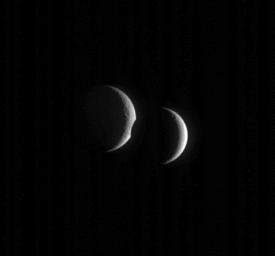
|
Uncovering Rhea
- Click the image above for a larger view
- Full-Res JPEG (342 x 318) (4.9 kB)
- Full-Res TIFF (342 x 318) (109.1 kB)
Caption:
Two Saturnian moons meet in the sky. Dione departs after crossing the face of Rhea for several minutes.
Dione (1,126 kilometers, or 700 miles across), at right, has a notably smoother-looking surface than Rhea (1,528 kilometers, or 949 miles across), suggesting the former has been modified more recently.
The image was taken in visible light with the Cassini spacecraft narrow-angle camera on May 14, 2006 at a distance of approximately 2.7 million kilometers (1.7 million miles) from Dione and 3.1 million kilometers (1.9 million miles) from Rhea. The Sun-moon-spacecraft, or phase, angle is about 134 degrees on both moons. Image scale is 16 kilometers (10 miles) per pixel on Dione and 18 kilometers (11 miles) per pixel on Rhea.
Background Info:
The Cassini-Huygens mission is a cooperative project of NASA, the European Space Agency and the Italian Space Agency. The Jet Propulsion Laboratory, a division of the California Institute of Technology in Pasadena, manages the mission for NASA's Science Mission Directorate, Washington, D.C. The Cassini orbiter and its two onboard cameras were designed, developed and assembled at JPL. The imaging operations center is based at the Space Science Institute in Boulder, Colo.
For more information about the Cassini-Huygens mission visit http://saturn.jpl.nasa.gov/home/index.cfm . The Cassini imaging team homepage is at http://ciclops.org .
Cataloging Keywords:
| Name | Value | Additional Values |
|---|---|---|
| Target | Rhea | Dione |
| System | Saturn | |
| Target Type | Satellite | |
| Mission | Cassini-Huygens | |
| Instrument Host | Cassini Orbiter | |
| Host Type | Orbiter | |
| Instrument | Imaging Science Subsystem (ISS) | |
| Detector | Narrow Angle Camera | |
| Extra Keywords | Grayscale, Visual | |
| Acquisition Date | ||
| Release Date | 2006-06-20 | |
| Date in Caption | 2006-05-14 | |
| Image Credit | NASA/JPL/Space Science Institute | |
| Source | photojournal.jpl.nasa.gov/catalog/PIA08203 | |
| Identifier | PIA08203 | |
